power steering Citroen C4 PICASSO 2016 2.G Owner's Manual
[x] Cancel search | Manufacturer: CITROEN, Model Year: 2016, Model line: C4 PICASSO, Model: Citroen C4 PICASSO 2016 2.GPages: 527, PDF Size: 13.72 MB
Page 29 of 527
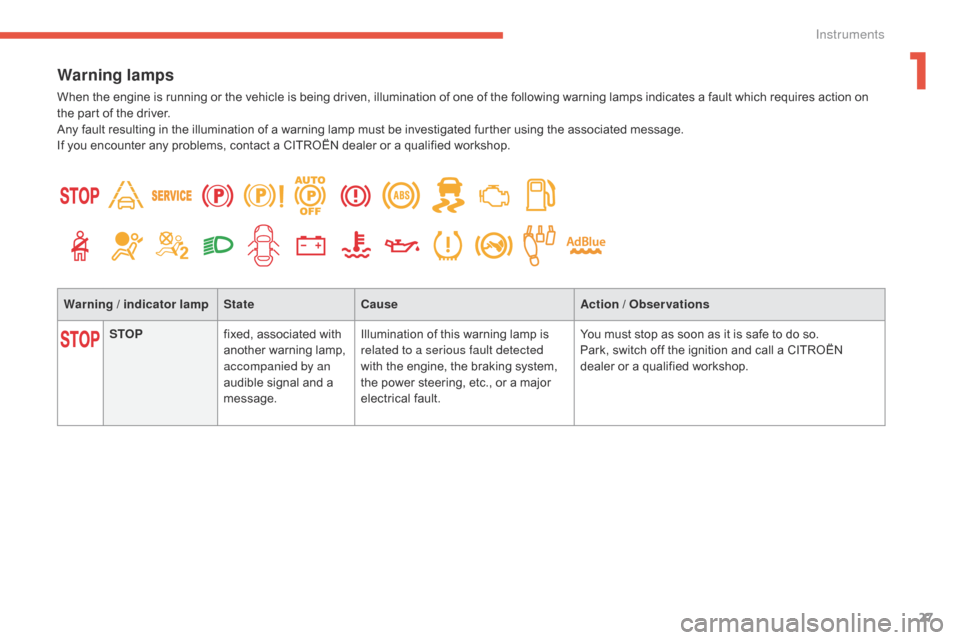
27
C4-Picasso-II_en_Chap01_instruments-bord_ed01-2016
Warning lamps
Whenô theô engineô isô runningô orô theô vehicleô isô beingô driven,ô illuminationô ofô oneô ofô theô followingô warningô lampsô indicatesô aô faultô whichô requiresô actionô onô the ô part ô of ô the ô driver.
Any
ô fault ô resulting ô in ô the ô illumination ô of ô a ô warning ô lamp ô must ô be ô investigated ô further ô using ô the ô associated ô message.
If
ô you ô encounter ô any ô problems, ô contact ô a ô CITROûN ô dealer ô or ô a ô qualified ô workshop.
Warning / indicator lamp StateCause Action / Observations
STOP fixed,
ô associated ô with ô
a
nother ô warning ô lamp, ô
a
ccompanied by an
audible
ô signal ô and ô a ô
m
essage.Illumination
ô of ô this ô warning ô lamp ô is ô
r
elated to a serious fault detected
with
ô the ô engine, ô the ô braking ô system, ô
t
he ô power ô steering, ô etc., ô or ô a ô major ô
e
lectrical
ô fa
ult.You
ô must ô stop ô as ô soon ô as ô it ô is ô safe ô to ô do ô so.
Park,
ô switch ô off ô the ô ignition ô and ô call ô a ô CITROûN ô
d
ealer ô or ô a ô qualified ô workshop.
1
Instruments
Page 107 of 527
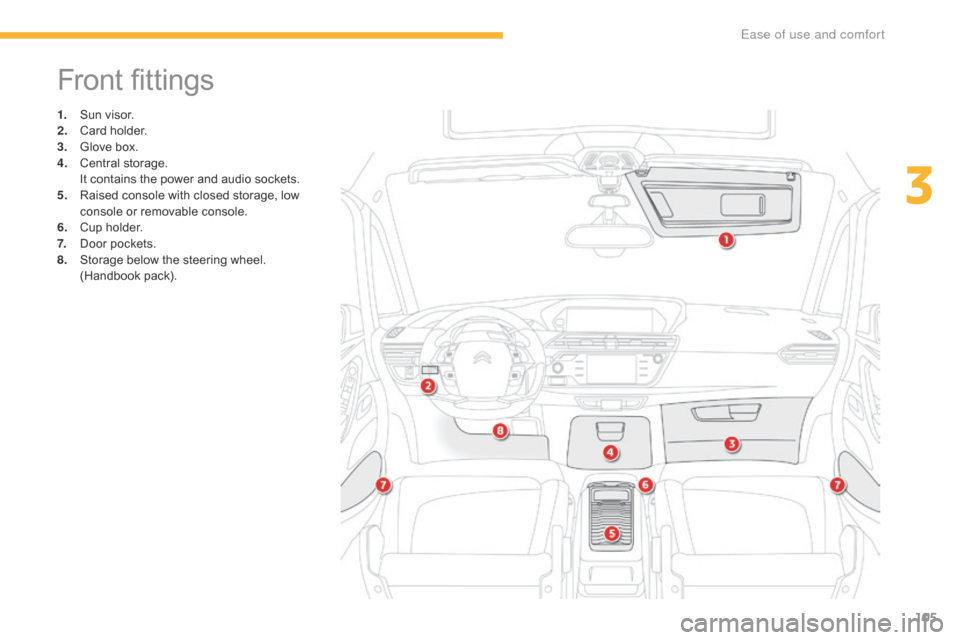
105
C4-Picasso-II_en_Chap03_ergonomie-confort_ed01-2016
Frontô fittings
1.ô Sunô visor.
2.ô C ard ô holder.
3.
ô G
love ô box.
4.
ô C
entral
ô s
torage.
ô I
t ô contains ô the ô power ô and ô audio ô sockets.
5.
ô R
aised ô console ô with ô closed ô storage, ô low ô
c
onsole ô or ô removable ô console.
6.
ô C
up ô holder.
7.
ô D
oor ô pockets.
8.
ô S
torage ô below ô the ô steering ô wheel.
ô (
Handbook ô pack).
3
Ease of use and comfort
Page 111 of 527
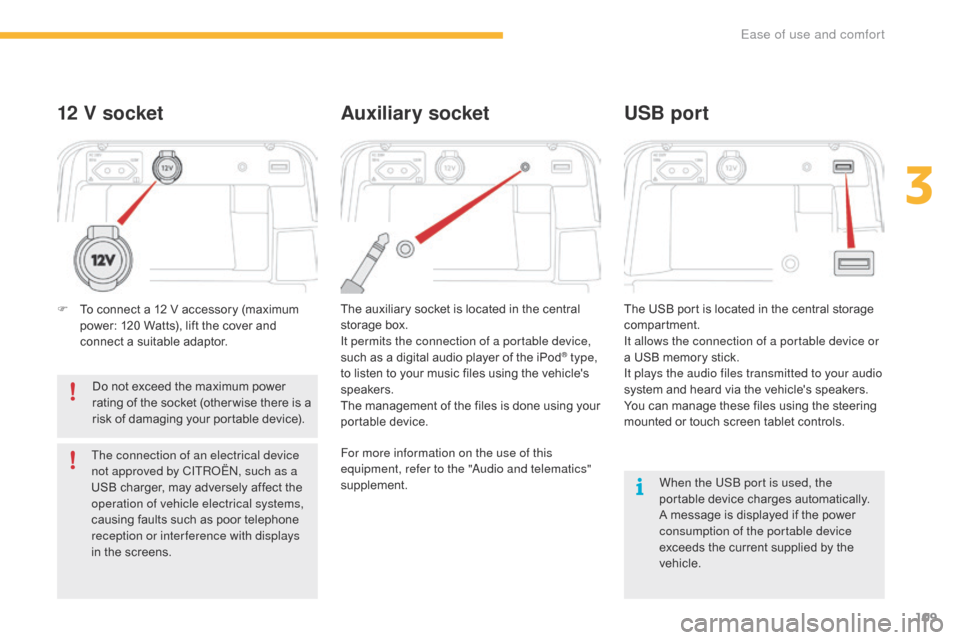
109
C4-Picasso-II_en_Chap03_ergonomie-confort_ed01-2016
When the USB port is used, the
portableô device ô charges ô automatically.
A
ô message ô is ô displayed ô if ô the ô power ô
c
onsumption of the portable device
exceeds
ô the ô current ô supplied ô by ô the ô
v
ehicle.
12 V socket
Theô auxiliaryô socketô isô locatedô inô theô centralô s torage ô box.
It permits the connection of a portable device,
such
ô as ô a ô digital ô audio ô player ô of ô the ô iPod
ôÛ type,
to
ô
listen
ô
to
ô
your
ô
music
ô
files
ô
using
ô
the
ô
vehicle's ô
s
peakers.
The
ô
management
ô
of
ô
the
ô
files
ô
is
ô
done
ô
using ô your ô
p
ortable
ô d
evice. The
ô USB ô port ô is ô located ô in ô the ô central ô storage ô
c
ompartment.
It allows the connection of a portable device or
a ô USB ô memory ô stick.
It plays the audio files transmitted to your audio
system
ô and ô heard ô via ô the ô vehicle's ô speakers.
You
ô can ô manage ô these ô files ô using ô the ô steering ô
m
ounted ô or ô touch ô screen ô tablet ô controls.
Auxiliary socketUSB port
For more information on the use of this
equipment, refer to the "Audio and telematics"
supplement.
F
ô
T
o
ô
connect
ô
a
ô
12
ô
V
ô
accessory
ô
(maximum
ô
p
ower:
ô
120
ô
Watts),
ô
lift
ô
the
ô
cover
ô
and
ô
c
onnect
ô
a
ô
suitable
ô
adaptor.
Do
ô
not
ô
exceed
ô
the
ô
maximum
ô
power
ô
r
ating
ô
of
ô
the
ô
socket
ô
(other wise
ô
there
ô
is
ô
a
ô
r
isk
ô
of
ô
damaging
ô
your
ô
portable
ô
device).
The connection of an electrical device
not approved by CITROûN, such as a
USB
ô
charger,
ô
may
ô
adversely
ô
affect
ô
the
ô
o
peration of vehicle electrical systems,
causing
ô
faults
ô
such
ô
as
ô
poor
ô
telephone
ô
r
eception or inter ference with displays
in
ô
the
ô
screens.
3
Ease of use and comfort
Page 148 of 527
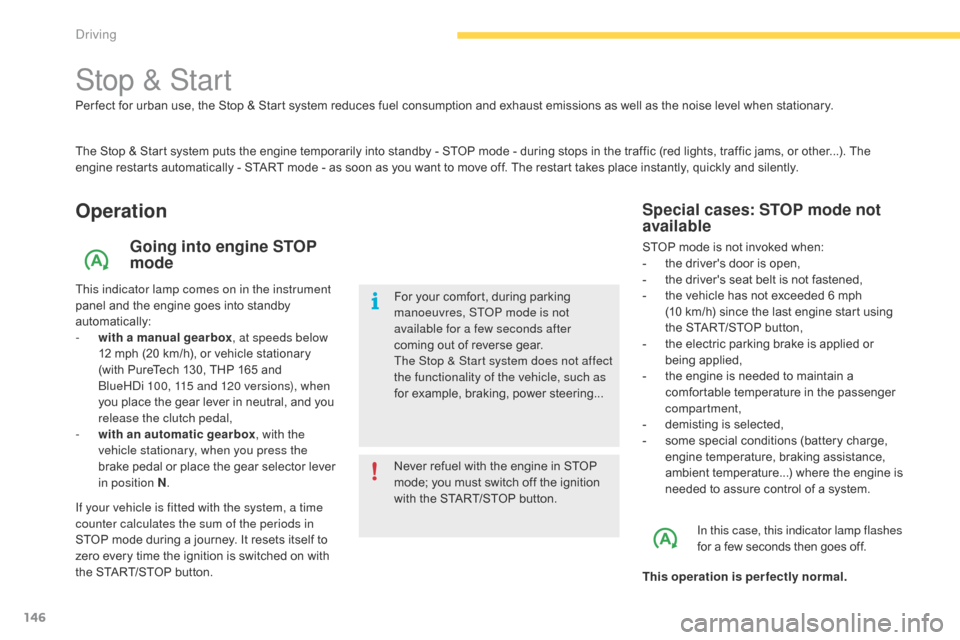
146
C4-Picasso-II_en_Chap04_conduite_ed01-2016
Stop & Start
Theô Stopô &ô Startô systemô putsô theô engineô temporarilyô intoô standbyô -ô STOPô modeô -ô duringô stopsô inô theô trafficô (redô lights,ô trafficô jams,ô orô other...).ô Theô engine ô restarts ô automatically ô - ô START ô mode ô - ô as ô soon ô as ô you ô want ô to ô move ô off. ô The ô restart ô takes ô place ô instantly, ô quickly ô and ô silently.
Operation
Going into engine STOP
mode
This indicator lamp comes on in the instrument
panelô and ô the ô engine ô goes ô into ô standby ô
au
tomatically:
-
w
ith a manual gearbox , at speeds below
12
ô mph ô (20 ô km/h), ô or ô vehicle ô stationary ô
(
with ô PureTech ô 130, ô THP ô 165 ô and ô
B
lueHDi 100, 115 and 120 versions), when
you
ô place ô the ô gear ô lever ô in ô neutral, ô and ô you ô
r
elease the clutch pedal,
-
w
ith an automatic gearbox , with the
vehicle stationary, when you press the
brake
ô pedal ô or ô place ô the ô gear ô selector ô lever ô
i
n position N . Never
ô refuel ô with ô the ô engine ô in ô STOP ô
m
ode; ô you ô must ô switch ô off ô the ô ignition ô
w
ith ô the ô START/STOP ô button.
For
ô your ô comfort, ô during ô parking ô
m
anoeuvres, STOP mode is not
available for a few seconds after
coming
ô out ô of ô reverse ô gear.
The Stop & Start system does not affect
the functionality of the vehicle, such as
for
ô example, ô braking, ô power ô steering...
Special cases: STOP mode not
available
STOPô modeô isô notô invokedô when:
- ô t he ô driver's ô door ô is ô open,
-
ô
t
he ô driver's ô seat ô belt ô is ô not ô fastened,
-
ô
t
he ô vehicle ô has ô not ô exceeded ô 6 ô mph ô
(10
ô km/h) ô since ô the ô last ô engine ô start ô using ô
t
he ô START/STOP ô button,
-
ô
t
he ô electric ô parking ô brake ô is ô applied ô or ô
be
ing
ô a
pplied,
-
ô
t
he ô engine ô is ô needed ô to ô maintain ô a ô
c
omfortable ô temperature ô in ô the ô passenger ô
c
ompartment,
-
ô
d
emisting ô is ô selected,
-
ô
s
ome ô special ô conditions ô (battery ô charge, ô
e
ngine ô temperature, ô braking ô assistance, ô
a
mbient ô temperature...) ô where ô the ô engine ô is ô
n
eeded ô to ô assure ô control ô of ô a ô system.
In this case, this indicator lamp flashes
forô a ô few ô seconds ô then ô goes ô off.
This operation is perfectly normal.
Per fect
ô
for
ô
urban
ô
use,
ô
the
ô
Stop
ô
&
ô
Start
ô
system
ô
reduces
ô
fuel
ô
consumption
ô
and
ô
exhaust
ô
emissions
ô
as
ô
well
ô as ô the ô noise ô level ô when ô stationary.
If your vehicle is fitted with the system, a time
counter calculates the sum of the periods in
STOP
ô
mode
ô
during
ô
a
ô
journey.
ô
It
ô
resets
ô
itself
ô
to
ô
z
ero
ô
every
ô
time
ô
the
ô
ignition
ô
is
ô
switched
ô
on
ô
with
ô t
he
ô
START/STOP
ô
button.
Driving
Page 194 of 527
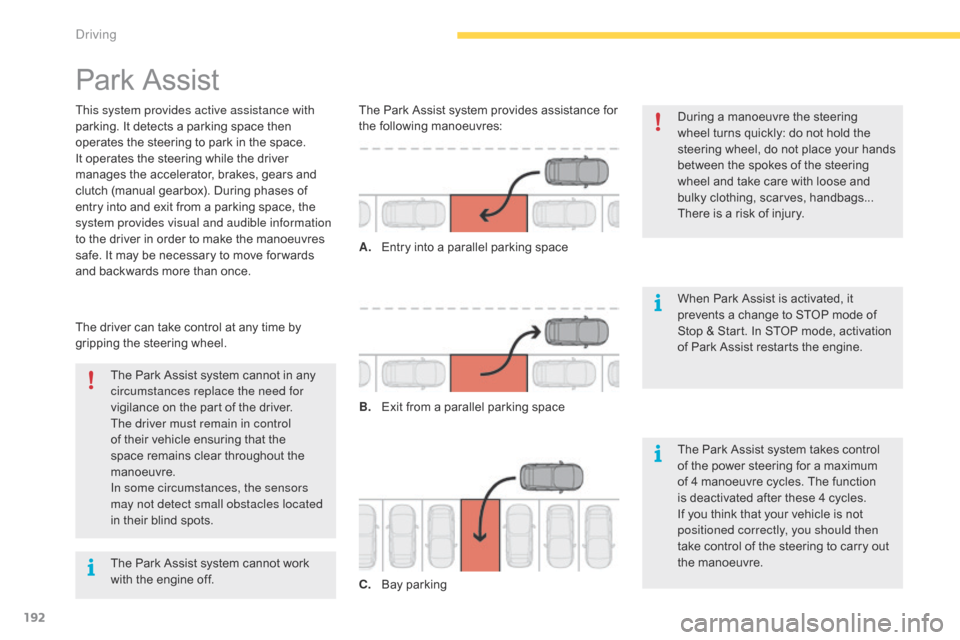
192
C4-Picasso-II_en_Chap04_conduite_ed01-2016
Parkô Assist
This system provides active assistance with
parking.ô It ô detects ô a ô parking ô space ô then ô
o
perates ô the ô steering ô to ô park ô in ô the ô space.
It
ô operates ô the ô steering ô while ô the ô driver ô
m
anages ô the ô accelerator, ô brakes, ô gears ô and ô
c
lutch ô (manual ô gearbox). ô During ô phases ô of ô
e
ntry ô into ô and ô exit ô from ô a ô parking ô space, ô the ô
s
ystem provides visual and audible information
to
ô the ô driver ô in ô order ô to ô make ô the ô manoeuvres ô
s
afe. ô It ô may ô be ô necessary ô to ô move ô for wards ô
a
nd ô backwards ô more ô than ô once. During
ô a ô manoeuvre ô the ô steering ô
w
heel ô turns ô quickly: ô do ô not ô hold ô the ô
s
teering ô wheel, ô do ô not ô place ô your ô hands ô
b
etween ô the ô spokes ô of ô the ô steering ô
w
heel ô and ô take ô care ô with ô loose ô and ô
b
ulky ô clothing, ô scarves, ô handbags... ô
T
here ô is ô a ô risk ô of ô injury.
When
ô Park ô Assist ô is ô activated, ô it ô
p
revents ô a ô change ô to ô STOP ô mode ô of ô
S
top ô & ô Start. ô In ô STOP ô mode, ô activation ô
o
f ô Park ô Assist ô restarts ô the ô engine.
The
ô Park ô Assist ô system ô cannot ô in ô any ô
c
ircumstances replace the need for
vigilance
ô on ô the ô part ô of ô the ô driver.
The driver must remain in control
of
ô their ô vehicle ô ensuring ô that ô the ô
s
pace ô remains ô clear ô throughout ô the ô
m
anoeuvre.
In some circumstances, the sensors
may not detect small obstacles located
in
ô their ô blind ô spots.
The
ô driver ô can ô take ô control ô at ô any ô time ô by ô
g
ripping ô the ô steering ô wheel. The
ô Park ô Assist ô system ô provides ô assistance ô for ô t
he ô following ô manoeuvres:
A.
ô E
ntry ô into ô a ô parallel ô parking ô space
B.
ô E
xit ô from ô a ô parallel ô parking ô space
C.
ô B
ay
ô par
kingThe
ô Park ô Assist ô system ô takes ô control ô
o
f ô the ô power ô steering ô for ô a ô maximum ô
o
f ô 4 ô manoeuvre ô cycles. ô The ô function ô
i
s ô deactivated ô after ô these ô 4 ô cycles. ô
I
f ô you ô think ô that ô your ô vehicle ô is ô not ô
p
ositioned correctly, you should then
take
ô control ô of ô the ô steering ô to ô carry ô out ô
t
he ô manoeuvre.
The
ô Park ô Assist ô system ô cannot ô work ô
w
ith ô the ô engine ô off.
Driving
Page 201 of 527
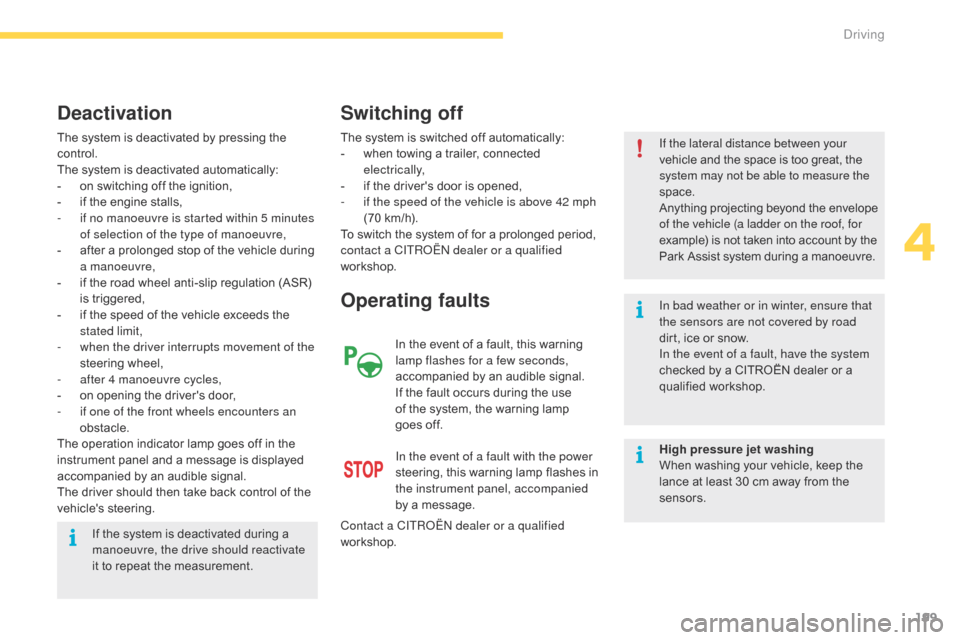
199
C4-Picasso-II_en_Chap04_conduite_ed01-2016
Theô systemô isô deactivatedô byô pressingô theô control.
The
ô system ô is ô deactivated ô automatically:
-
ô
o
n ô switching ô off ô the ô ignition,
-
ô
i
f ô the ô engine ô stalls,
-
i
f no manoeuvre is started within 5 minutes
of selection of the type of manoeuvre,
-
ô
a
fter ô a ô prolonged ô stop ô of ô the ô vehicle ô during ô
a
manoeuvre,
-
ô
i
f ô the ô road ô wheel ô anti-slip ô regulation ô (ASR) ô
i
s
ô t
riggered,
-
ô
i
f ô the ô speed ô of ô the ô vehicle ô exceeds ô the ô
s
tated limit,
-
w
hen the driver interrupts movement of the
steering
ô w
heel,
-
a
fter 4 manoeuvre cycles,
-
ô
o
n ô opening ô the ô driver's ô door,
-
i
f one of the front wheels encounters an
obstacle.
The
ô operation ô indicator ô lamp ô goes ô off ô in ô the ô
i
nstrument ô panel ô and ô a ô message ô is ô displayed ô
a
ccompanied ô by ô an ô audible ô signal.
The
ô driver ô should ô then ô take ô back ô control ô of ô the ô
v
ehicle's
ô s
teering.
Deactivation
Theô systemô isô switchedô offô automatically:
- ô w hen ô towing ô a ô trailer, ô connected ô
e
lectrically,
-
ô
i
f ô the ô driver's ô door ô is ô opened,
-
i
f the speed of the vehicle is above 42 mph
(70
ô km/h).
To
ô switch ô the ô system ô of ô for ô a ô prolonged ô period, ô
c
ontact a CITROûN dealer or a qualified
workshop.
Operating faults
In the event of a fault with the power
steering, ô this ô warning ô lamp ô flashes ô in ô
t
he instrument panel, accompanied
by
ô a ô message.
Contact a CITROûN dealer or a qualified
workshop.
Switching off
If the lateral distance between your
vehicle ô and ô the ô space ô is ô too ô great, ô theô s
ystem may not be able to measure the
space.
Anything
ô projecting ô beyond ô the ô envelope
ô o
f the vehicle (a ladder on the roof, for
example)
ô is ô not ô taken ô into ô account ô by ô the
ô P
ark ô Assist ô system ô during ô a ô manoeuvre.
In bad weather or in winter, ensure that
the sensors are not covered by road
dirt,
ô ice ô or ô snow.
In the event of a fault, have the system
checked
ô by ô a ô CITROûN ô dealer ô or ô a ô
q
ualified
ô w
orkshop.
If
ô
the
ô
system
ô
is
ô
deactivated
ô
during
ô
a
ô
ma
noeuvre, the drive should reactivate
it
ô
to
ô
repeat
ô
the
ô
measurement. In
ô
the
ô
event
ô
of
ô
a
ô
fault,
ô
this
ô
warning
ô
l
amp flashes for a few seconds,
accompanied
ô
by
ô
an
ô
audible
ô
signal.
If
ô
the
ô
fault
ô
occurs
ô
during
ô
the
ô
use
ô
o
f
ô
the
ô
system,
ô
the
ô
warning
ô
lamp
ô
g
oesô off. High pressure jet washing
When
ô washing ô your ô vehicle, ô keep ô the ô
l
ance ô at ô least ô 30 ô cm ô away ô from ô the ô
sen
sors.
4
Driving
Page 321 of 527
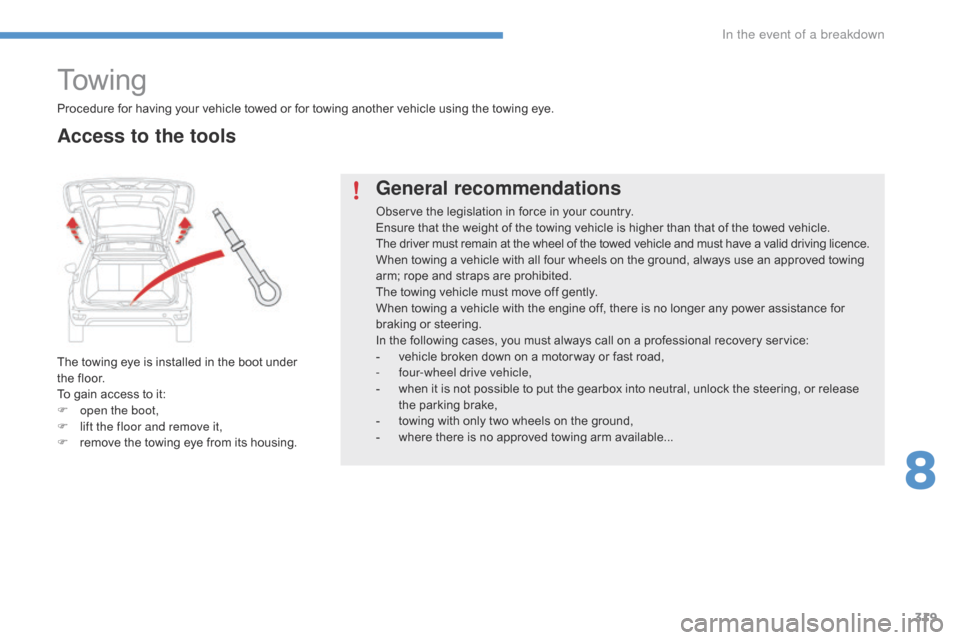
319
C4-Picasso-II_en_Chap08_en-cas-panne_ed01-2016
To w i n g
Theô towingô eyeô isô installedô inô theô bootô underô the ô floor.
To
ô gain ô access ô to ô it:
F
o
pen the boot,
F
l
ift the floor and remove it,
F
ô
r
emove ô the ô towing ô eye ô from ô its ô housing.
General recommendations
Observeô theô legislationô inô forceô inô yourô country.
E nsure ô that ô the ô weight ô of ô the ô towing ô vehicle ô is ô higher ô than ô that ô of ô the ô towed ô vehicle.
The
ô driver ô must ô remain ô at ô the ô wheel ô of ô the ô towed ô vehicle ô and ô must ô have ô a ô valid ô driving ô licence.
When
ô towing ô a ô vehicle ô with ô all ô four ô wheels ô on ô the ô ground, ô always ô use ô an ô approved ô towing ô
a
rm; ô rope ô and ô straps ô are ô prohibited.
The
ô towing ô vehicle ô must ô move ô off ô gently.
When
ô towing ô a ô vehicle ô with ô the ô engine ô off, ô there ô is ô no ô longer ô any ô power ô assistance ô for ô
b
raking ô or ô steering.
In
ô the ô following ô cases, ô you ô must ô always ô call ô on ô a ô professional ô recovery ô service:
-
ô
v
ehicle ô broken ô down ô on ô a ô motor way ô or ô fast ô road,
-
f
our-wheel drive vehicle,
-
ô
w
hen ô it ô is ô not ô possible ô to ô put ô the ô gearbox ô into ô neutral, ô unlock ô the ô steering, ô or ô release ô
t
he ô parking ô brake,
-
ô
t
owing ô with ô only ô two ô wheels ô on ô the ô ground,
-
ô
w
here ô there ô is ô no ô approved ô towing ô arm ô available...
Procedure
ô
for
ô
having
ô
your
ô
vehicle
ô
towed
ô
or
ô
for
ô
towing
ô
another ô vehicle ô using ô the ô towing ô eye.
Access to the tools
8
In the event of a breakdown